|
July
2001 Vol. 222 No. 7
Feature Article
|
Well
Control / Intervention
Well control during well intervention
Part 4 –
Selecting proper coiled tubing well control equipment
Recommended
well control stack and flow control device configurations are given, in
addition to considerations for properly sizing CT string OD
Alex
Sas-Jaworsky II, SAS Industries, Inc., Houston
The design of
concentric tube well servicing technology provides the means to
conduct well intervention operations while maintaining required
barriers for pressure and fluid flow control at the surface. For
coiled tubing (CT) operations, the primary mechanism for maintaining
pressure and fluid containment is the purpose-built well control stack
working in combination with fluid flow control devices in the surface
treatment piping.
Due to the
specific equipment component functions and operating practices used in
underbalanced CT applications, well control practices require greater
attention during preparation and implementation. This article provides
an overview of the recommended CT well control stack and flow control
device configurations for defined pressure control conditions, plus
considerations for proper OD sizing of the CT string.
Maximum
Surface Pressure Assessment
When selecting
the appropriate CT well control stack pressure rating, an assessment
must be made to determine the maximum surface pressure expected for
the prescribed service. The first step requires that a hydrostatic
pressure calculation be performed to determine maximum anticipated
surface pressure (MASP) within the wellbore. API RP 5C7
stipulates that the MASP, which is defined as the highest pressure
that may be encountered at surface for the given operation, be used to
determine the pressure rating of the well control stack and related
riser components. For well intervention services, the MASP is
typically found by subtracting the hydrostatic pressure exerted by a
column of compressed dry gas (as measured from the
surface-to-reservoir true vertical depth) from the static pressure of
the formation(s) open to the wellbore.
The hydrostatic
pressure exerted by a column of dry gas (PGas,
psig) may be calculated using Eq. 1, where gg
represents gas specific gravity, Pi is hydrostatic
pressure of the incremental gas column height in psig, HHyd
is true vertical height of the gas column increment in feet, TG
is gas temperature in °R and Z is gas compressibility
factor.
Through
summation of gas column height increments, PGas
can be calculated for a given wellhead pressure (P0)
from surface to the desired depth for the specified conditions. This
series of calculations requires trial and error iterations in order to
determine P0 (in psia) which, when added to the
hydrostatic pressure of the gas column, will balance the reservoir
pressure.
An example
illustrating the predicted density of columns of 0.65-S.G. compressed
natural gas is offered in Fig. 1 for wellhead pressures of 200 psig
and 2,000 psig, respectively, assuming a temperature gradient of 0.014°F/ft.
This example demonstrates how the gas density increases at increasing
TVD, yielding the respective hydrostatic pressures at depth when the
natural gas column is subjected to the specified amount of pressure at
surface.
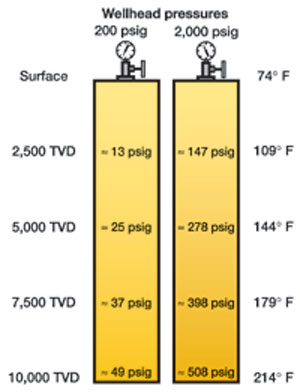 |
|
Fig.
1. Example shows predicted hydrostatic pressures at depth
for columns of 0.65-S.G. compressed natural gas under
different wellhead pressures (temperature gradient of 0.014°F/ft). |
|
Once MASP is
predicted, the next step is to determine the maximum expected surface
pump pressure exposed within the stack prior to confirming the
pressure rating of the surface well control equipment to be used. For
this assessment, it is assumed that pressure integrity of the tube
above the stripper has been compromised, and a circulation kill
program must be performed. In this case, CT must be hung within the
slip rams and mechanically separated using the shear rams. Once CT has
been sheared, the tube is pulled upward to clear the blind rams
position in the well control stack, and the blind rams are closed. The
blind rams form a pressure barrier within the well control stack above
the sheared CT and provide a means for pumping down the CT when
conducting a circulation kill program.
This pumping
pressure evaluation requires that OD, ID and length of CT in the well
be defined, along with the density and rheology of the fluids to be
pumped during the prescribed service or well control program. This
exercise must incorporate the desired performance of the treatment
fluids pumping program, along with the predicted behavior of the
kill-weight fluids when circulated to achieve pressure balance within
the wellbore. The maximum expected pump pressure, when added to MASP,
cannot exceed the working pressure rating of the well control stack
for the prescribed service.
Well
Control Stack Components
As previously
discussed, the well control stack serves as the primary barrier for
maintaining isolation of wellbore pressure and fluids at the surface
in CT services. The minimum CT well control stack assembly components
defined in API RP 5C7 are shown below:
- One stripper
or annular-type component
- One blind
ram component
- One shear
ram component
- One kill
line outlet with valves
- One slip ram
component
- One pipe ram
component.
Options are
allowed for combining the blind and shear ram functions into a single
ram operation. Similarly, the slip and pipe ram functions may be
combined into a single ram. The orientation and function of the
components listed above should be considered as the minimum well
control stack configuration for CT service operations. Additional CT
well control components recommended within API RP 5C7 include
a flow tee or cross, along with a safety pipe ram mounted below the
quad-ram stack. If the wellhead crown valve is incapable of holding
pressure from above for pressure testing purposes, a separate gate
valve should be installed at the base of the well control stack riser,
directly above the crown valve. A detailed review of the function and
performance expectation for each well control component is outlined in
API RP 5C7, with recommendations offered for pump, kill and
choke / returns surface piping.
As acceptable
limits for CT service and pumping pressures increased, the selection
of appropriate well control equipment pressure rating required
additional attention. The guidelines shown in Table 1 classify the
well control stack pressure service category (PSC) ratings for CT
intervention services where bend-cycling occurs with the tube exposed
to the designated MASP shown below. For all service categories, the
difference between MASP and expected pump pressure offered in Table 1
roughly translates to the maximum amount of frictional pressure loss
expected when circulating kill-weight fluids through the remaining
segment of CT hung within the well control stack, within the annuli
and back to surface. For example, the PSC 1 case suggests that the
increase in pump pressure allowed for performing the circulation kill
is 1,500 psig (see Table 1).
| |
Table
1. Well control stack service categories |
|
| |
Pressure
service
category |
Well
control
stack rated
WP, psig |
Maximum
pressure
|
|
| |
Anticipated
surface, psig |
Expected
pumping, psig |
|
| |
PSC
1 |
5,000 |
3,500 |
5,000 |
|
| |
PSC
2 |
10,000 |
7,500 |
10,000 |
|
| |
PSC
3 |
15,000 |
10,000 |
12,500 |
|
| |
PSC
4 |
15,000 |
12,500 |
15,000 |
|
|
The various
service categories of well control equipment shown in Table 1 are
discussed below and are offered as a guideline for use in determining
the level of preparation for a prescribed CT service. As the service
category rating increases, performance requirements stipulated for the
lower categories must be maintained, with the additional performance
requirements determined by the service and pressures expected during
the operation.
Service
category 1. In a PSC 1 environment, maximum recommended surface
wellbore pressure is 3,500 psig, with a maximum surface pumping
pressure of 5,000 psig through the kill line and CT. The PSC 1
category (Fig. 2) requires that the well control stack and related
piping be rated to a minimum working pressure of 5,000 psig. The
surface piping requirements for the pump, kill line and returns /
choke lines conform to API RP 5C7, with the addition of a
pumping cross to direct pumped fluids to the CT reel or the kill
spool. The manually adjustable dual choke allows service to be
diverted to the back-up choke if the primary choke fails. A separate
pressure recorder may be used to record pump and choke pressures
independent of the CT unit.
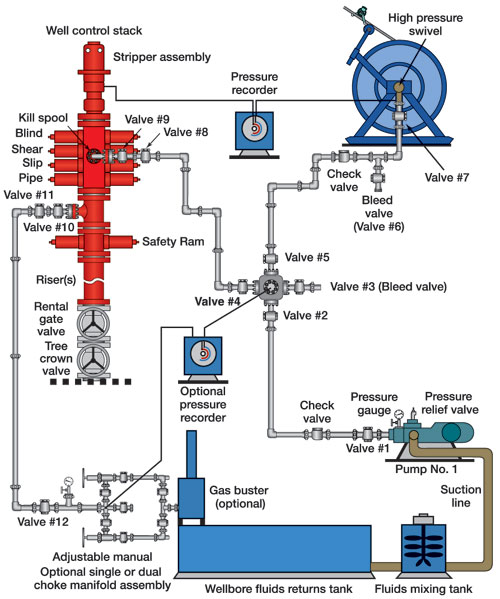 |
|
Fig.
2. Recommended well control equipment components for
pressure service category (PSC) 1 operations. |
|
Service
category 2. In a PSC 2 environment, maximum recommended surface
well pressure is 7,500 psig, with a maximum surface pumping pressure
of 10,000 psig through the CT. For the PSC 2 category, the well
control stack and related piping should have a minimum working
pressure rating of 10,000 psig, with the recommended surface well
control components seen in Fig. 3.
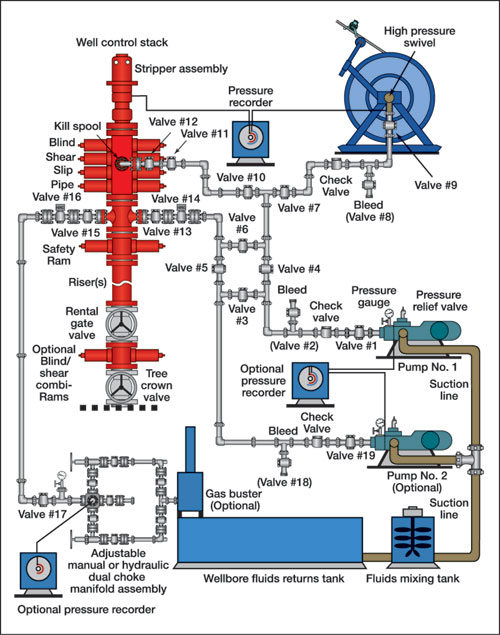 |
|
Fig.
3. Recommended well control equipment components for PSC 2
operations. |
|
The surface
piping includes additional pressure isolation valves and a pumping
manifold to allow for directing the pumped fluids to the CT service
reel and the flow cross on the well control stack. Should the
situation dictate that CT be sheared to allow the blind rams to be
closed, the kill program can be conducted by directing the pumped
fluids to the kill spool and down the CT string remaining within the
wellbore, to the flow cross on the well control stack, or both.
The surface
piping to the well control stack for PSC 2 operations should be
connected through flanged, high-pressure valve assemblies. In
addition, the outboard valve on the flow tee or flow cross should be
equipped with a remote hydraulic actuator for rapid closure in an
emergency. The dual-choke manifold may be manually or remotely
adjustable using hydraulic actuators. A separate pressure recorder may
be used to record pump and choke pressures independent of the CT unit
console.
Depending upon
prescribed service and wellbore MASP, blind / shear combination rams
should be considered for use within the well control stack riser
assembly. In addition, a second high-pressure pump should be
considered as a backup pump or emergency kill pump.
Service
categories 3 and 4. In the PSC 3 case, the maximum recommended
surface well pressure is 10,000 psig, with a maximum surface pumping
pressure of 12,500 psig through the CT. For the PSC 4 case, maximum
recommended surface well pressure is 12,500 psig, with a maximum
surface pumping pressure of 15,000 psig. In both PSC 3 and PSC 4
environments, the well control stack and related piping should have a
minimum working pressure rating of 15,000 psig, with the recommended
surface well control components seen in Fig. 4.
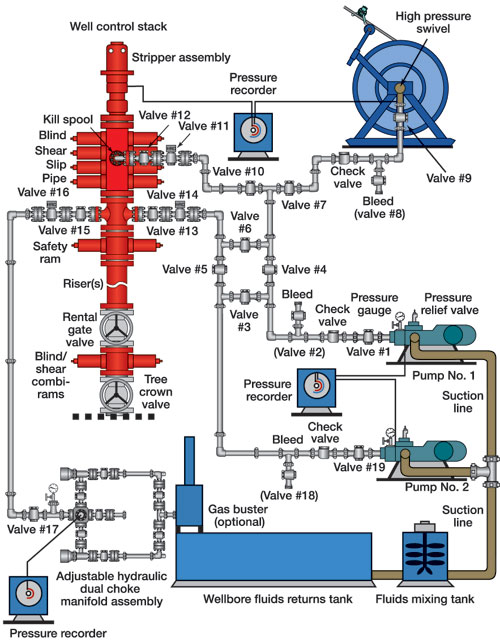 |
|
Fig.
4. Recommended well control equipment components for PSC 3
and 4 operations. |
|
In the context
of pressure service level ratings, a distinction is made between the
PSC 3 and PSC 4 categories with respect to the design of the CT
string, material yield strength and type of material used to construct
the string. The predicted bend-cycle fatigue service life, along with
the anticipated changes in the tube OD and wall thickness(es)
resulting from diametral growth, must be considered when evaluating
the expected performance of the well control stack component functions
and pressure sealing capabilities.
The surface
piping recommendations for the PSC 3 and 4 categories are similar to
the configuration offered for PSC 2 operations, but with a minimum
working pressure rating of 15,000 psig. The dual-choke manifold should
be remotely operated using hydraulic actuators, and a separate
pressure recorder should be used to record pump and choke pressures
independent of the CT unit. For any service in which MASP exceeds
7,500 psig, blind / shear combi-rams should be included in the well
control stack riser assembly as a rule. In addition, a second
high-pressure pump also should be incorporated as a backup pump or
emergency kill pump.
Bottomhole
Assembly Components
In the design
of any CT well intervention service, the bottomhole assembly (BHA)
components need to be selected based on performance for the intended
service. The functions of CT BHA components used in underbalanced
wellbore environments provide additional pressure safety features to
protect the CT string and should be construed as fundamental to well
control. The basic components that should be incorporated in all CT
well control BHAs include connector, pressure check valve(s) and a
type of fluids dispersion nozzle as discussed below.
The CT
connector selected must provide all needed mechanical load and
pressure-containment functions projected for the prescribed service.
As such, the connector must be capable of mechanically securing the
BHA components to the CT string within the axial load limits expected
for the prescribed service. In addition, the connector must also be
capable of providing pressure isolation between the CT body and the
connector to the MASP of the wellbore.
In all
underbalanced pressure environments, a pressure check valve component
is considered to be a critical well control device and should always
be incorporated in the BHA. The pressure check valve serves to
restrict or severely reduce flow from the wellbore into the CT string
should the tubing string experience a loss of internal pressure due to
mechanical failure above the well control stack. As such, the pressure
check valve is typically installed immediately below the CT connector.
These pressure check valves may be designed as ball- or flapper-type,
and may be run as a single valve or as tandem valves within a single
housing.
The fluid
dispersion nozzle is typically selected based on the downhole
hydrodynamic action desired. In some CT services, a multi-port
dispersion nozzle may be omitted if downhole hydraulic energy is not a
key performance issue. However, when conducting well control
operations, the fluid dispersion nozzle generates a hydrodynamic fluid
plume within the wellbore, which ensures localized dispersion of kill
fluids, with minimum intermixing of resident fluids. For prudent well
control operations, the fluid dispersion nozzle should be designed
with multi-port jets that are capable of focusing the exiting fluid
streams to contact the ID boundaries of the wellbore tubulars while
minimizing frictional pressure loss.
Selection
of CT Size
In general, CT
size for the prescribed service is determined by the allowable
clearances between the tube OD and the minimum restrictions within the
wellbore, coupled with the need to achieve a specified fluids pumping
rate. Further CT size may be dictated by logistical concerns for the
total reel transport weight, with respect to crane load limits or
weight restrictions for overland transport.
One additional
concern that should be included in CT size selection analysis is the
maximum width dimension of the CT body, should plastic collapse occur.
In cases where non-uniform loading on the CT body causes the tube to
collapse on only one side, a slight dimensional distortion of the
original tube diameter will occur. However, when a tube experiences
complete plastic collapse, the tube walls are flattened together, with
the outside boundary edges of the flattened tube specimen retaining a
slightly-rounded shape.
When evaluating
CT OD sizes for a prescribed service, the maximum collapse width of
the tube should not exceed the ID of the smallest restriction in the
given completion tubing. This dimensional check ensures that, should a
collapse event occur, the increased tube width will not cause the body
to become jammed within the completion tubulars, restricting movement
of the CT within the production tubing. The maximum width of the
collapsed tube body also provides an estimate of annular clearance
available between the collapsed tube and hole ID.
Of equal
concern is the maximum flattened width of the tube with respect to the
proper function of the shear blades when an emergency separation of
the collapsed tube body is required. For this analysis, the maximum
collapsed width of the tube body should be compared to the effective
cutting surface length on the shear blades installed within the
primary well control stack (typically sized for the respective tube
OD). If the maximum collapse width of the tube exceeds the effective
cutting surface length of the shear blade, the outside edges of the
blade will be mechanically loaded against the flattened tube body,
leading to possible blade breakage and/or incomplete shear of the tube
body. In this situation, it is recommended that a combination blind /
shear ram, equipped with blades having sufficient cutting surface
length, be installed within the riser.
To assist this
evaluation, the maximum width (Wmax) of a
collapsed tube may be predicted using Eq. 2, in which original tube OD
size (DC, in.) and actual wall thickness (t,
in.) dimensions are known. Note that for a given tube OD, the maximum
collapsed width will decrease with increasing wall thickness.
| |
 |
The maximum
width value calculated using Eq. 2 was found to be consistent with
measurements of mechanically flattened tube specimens. However, in
comparison to pressure-collapsed tube specimens, the maximum width of
these tube specimens ranged from 93% to 98% of the mechanically
flattened width, due to retained curvature at the edges of the OD
surface, Fig. 5. When predicting the width of a pressure-induced,
plastically collapsed tube body, a factor of 0.95 applied to the
maximum flattened width value calculated in Eq. 2 should yield close
agreement with the dimension of the collapse sample. The predicted
values for maximum flattened width and plastically collapsed width are
seen in Table 2 for specific CT sizes having a DC/t
ratio between 13 and 14.
| |
Table
2. Calculated maximum width of tube sizes |
|
| |
Coiled
tubing OD
size, in. |
Measured
tube wall
thickness, in. |
Maximum
width dimension
|
|
| |
Calculated
(flattened), in. |
Calculated
(collapse), in. |
|
| |
1.250 |
0.095 |
1.855 |
1.763 |
|
| |
1.500 |
0.109 |
2.232 |
2.120 |
|
| |
1.750 |
0.125 |
2.606 |
2.476 |
|
| |
2.000 |
0.145 |
2.976 |
2.827 |
|
| |
2.375 |
0.175 |
3.531 |
3.354 |
|
| |
2.875 |
0.203 |
4.284 |
4.070 |
|
|
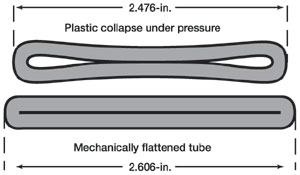 |
|
Fig.
5. Maximum width of a collapsed tube should be calculated
to ensure proper clearances are maintained. The maximum width
of pressure-collapsed tube specimens range from 93% to 98% of
the mechanically flattened width due to retained curvature at
the edges of the OD surface. |
|
Condition
of CT and Remaining Service Life
Once the
appropriate CT size for the prescribed job has been determined, an
evaluation of the service history with predictions of remaining string
bend-cycle service life should be performed to assess "fitness-for-service."
This analysis of the CT string should incorporate model predictions
for accumulated fatigue-cycle damage, as well as de-rating factors for
internal and external surface corrosion and mechanical damage. The
prediction for remaining string service life must project the expected
manipulation of the tubing string within the wellbore when deployed
and retrieved at the proposed pumping pressures, and retain acceptable
life through-out the entire service program. 
Bibliography
1
World Oil’s Coiled Tubing Handbook, 3rd Edition, Gulf
Publishing Company, Houston, TX, 1998.
2
American Petroleum Institute, Recommended Practice for Coiled
Tubing Operations in Oil and Gas Well Services, API RP 5C7, First
Edition, December, 1996.
3
Sas-Jaworsky, A., Practical Considerations for Enhancing Coiled Tubing
Well Control Operations, SPE paper 60739, SPE/ICoTA Coiled Tubing
Roundtable, Houston, Texas, April 5 – 6, 2000.
4
McCain, W. D. Jr., The Properties of Petroleum Fluids, The
Petroleum Publishing Co., Tulsa, OK, 1973.
5
Sas-Jaworsky, A., "New guidelines should enhance coiled tubing
well control security," World Oil, December, 1998.

The
author |
 |
Alexander
Sas-Jaworsky II is founder and principal engineer of SAS
Industries, Inc., formed in 1995 and specializing in mechanical
testing, training and service consultation for all aspects of
applied coiled tubing technology. He began his career with Conoco
after receiving a BS in petroleum engineering at the University of
Southwestern Louisiana in 1982, and he worked for various coiled
tubing companies before and while attending college. He worked in
several Conoco divisions as a production engineer before
transferring to the Conoco Houston Production Technology group in
December 1990 as worldwide concentric workover consultant for
coiled tubing and snubbing. He is a registered professional
engineer in Louisiana and Texas, SPE member, and serves on API
committee 3/subcommittee16 as chairman of the well intervention
well control task group. |
| |
|
 |
 Part
1 Part
1 |
 Part
2 Part
2 |
 Part
3 Part
3 |
 Part
5 Part
5 |
|









